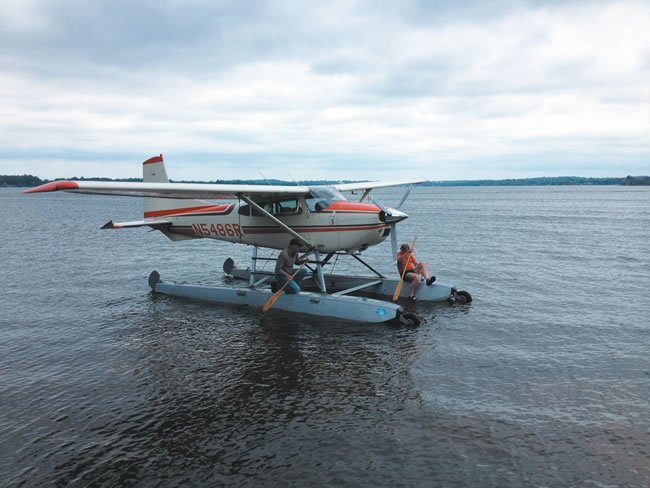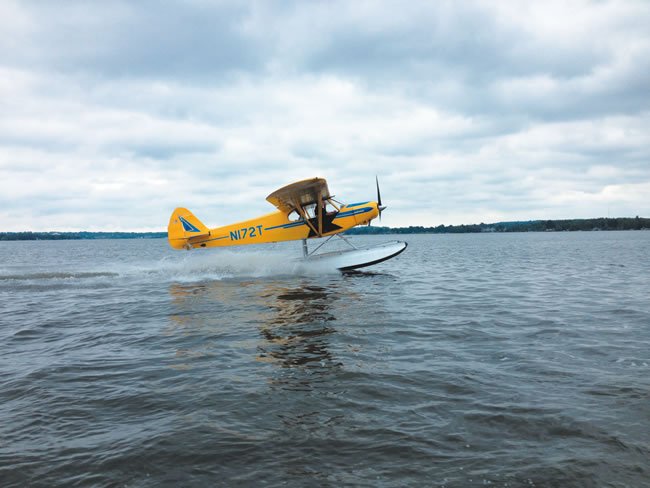This article started with an email from a reader asking whether a Cessna 150 would be a good floatplane. It morphed from conversations with experienced floatplane pilots about the 150 on floats-okay, but not great-into what makes a good floatplane, what to look for when buying one and whats involved in putting floats on your airplane.
To keep the subject within limits, we’ll limit the discussion to floatplanes weighing 4000 pounds or less and omit flying boats-after all, we covered the most popular, the Lake Amphibian, in detail in our Used Aircraft Guide back in the January 2014 issue.
Given all that, what are the criteria for a good floatplane and the variables to be considered when finding the right one for you?

Power-to-Weight Ratio
The first thing Alaska floatplane pilot and flight instructor Terry Dickinson pointed to when discussing his criteria for a good seaplane is its power-to-weight ratio. It has to haul around the weight and drag of two boat hulls that can withstand the pounding involved with going fast on the water and the attaching hardware. That takes power.
Adding to the challenge, on takeoff a seaplane has to transition from plowing through the water, with the floats mostly submerged, onto the step where they plane on the surface. To do so, the pilot initially holds the yoke or stick full aft to force the aircrafts nose up and the engine manhandles the floats onto the step. The pilot then lowers the nose to just above level attitude so that the drag of the water is minimized and the airplane can accelerate to flying speed.
The better the power-to-weight ratio, the faster the airplane gets onto the step and into the air-and the less skill and finesse that is required of the pilot.
The power end of the ratio is expensive-so while a great floatplane has a high power-to-weight ratio, a good one for you should have: Enough power to get on the step without requiring superhuman finesse; a takeoff length for safety in the available area and a climb rate that will easily clear obstructions where you are planning to operate.
The other end of the ratio is too often overlooked. Controlling weight in floatplanes matters because it greatly affects takeoff distance and rate of climb. A heavy, high-end interior is not a plus in a floatplane-Spartan is better.
Float size
Floats are identified by numbers that indicate the maximum amount of weight, in pounds, of fresh water they displace when fully submerged. A 2000 means the float will displace 2000 pounds. FAA certification requires that the total displacement of the floats must be at least 1.8 times the gross weight of the floatplane. So a floatplane on a set of 2000 floats can have a max gross weight of just over 2222 pounds.
There’s a tradeoff in float selection-the more weight the set of floats can support, the bigger, draggier and heavier they are. On first blush, that means using the smallest allowable floats for the airplane. However, that means more of the float is underwater, which adversely affects maneuverability and ability to handle rough water and stronger wind; it also means that its more difficult to get the floats onto the step, lengthening the takeoff run.
Derek DeRuiter, owner of Northwoods Aviation, a seaplane operation in Cadillac, Michigan, told us of bad experiences in a Cessna 172 with the minimum allowable floats, a set of 2000s. When making taxi turns on windy days, it was not uncommon for the downwind float to completely submerge, making maneuvering difficult and risking capsizing.
Often an airplane will have at least two different size floats approved-doing some homework with those knowledgeable about the aircraft and floats is necessary before making a purchase decision.
Handling
Because of the side area of the floats forward of the aircraft c.g., they destabilize the airplane in yaw. Tom Wallis has done flight testing for numerous singles and twins on floats and told us that flight testing may demonstrate the need for the addition of more side area on the aft portion of the airframe to provide adequate stability and control. This is usually involves installing a dorsal fin on the empennage or finlets on the horizontal stabilizer.



Maneuverability on the water is important at slow speed in crowded areas and at high speed during takeoff and landing. Even though floatplanes have water rudders to improve steering at low speeds (they are raised out of the water for takeoff and landing), some airplane and float combos are better than others.
Smaller lakes, odd-shaped bays or operations on rivers mean that normal takeoffs and landings may involve turns while the airplane is on the step on takeoff or landing. For example, Seaplane Adventures is based at a location in Sausalito, California, where each takeoff involves a sharp 90-degree left turn. We made flights with company owner Aaron Singer as he graphically demonstrated the importance of selecting a floatplane that is capable of handling the conditions where an owner is going to base it.
Useful load
Most STCs for float installation include an increased gross weight for the airplane. That sounds great until you look at the numbers-the weight of the floats is greater than the gross weight increase, so useful load will go down. A useful rule of thumb is that, with floats, many two-place airplanes become single-place if more than an hour of so of fuel is aboard and four-place airplanes become two- to three-place.
When considering any floatplane, look closely at the useful load to assure that the airplane will work for your needs.


Stall speed
Seaplanes generally come off the water near their stall speed and land four or five knots above it. Accordingly, the lower the stall speed, the less pounding the airframe receives at high speed on the waves.
STOL kits may be worth their weight, but we feel that each has to be evaluated based on how much useful load is lost versus stall speed decrease. We think VGs are worth the price as they reduce stall speed measurably and don’t add more than a pound or two to the airframe.
A number of pilots we spoke with highly recommended the wingtip extensions available for the Cessna 180, 185 and 206 in terms of substantially reducing takeoff run.
Doors
Weve seen things go wrong fast when taxiing a seaplane. We, and the operators and pilots we spoke with, prefer doors on both sides of the aircraft so the pilot can get out quickly. Thats a shortcoming with most of the two-place tandem seaplanes and is one reason that the copilots door mod for the Cessna 206 is popular.
If you are considering a floatplane with a single door, plan on consciously making all your turns when taxiing so that the door is into the wind. If a gust upsets the floatplane, you want the door side to be up.


Visibility
Being able to see whats going on around the aircraft when taxiing, taking off and landing is important-especially when hitting objects or debris in the water can have serious consequences.
In general, two-place tandem floatplanes give the pilot better all-around visibility than side-by-side seating. Some floatplanes are blind forward during the process of getting on the step; minimizing that time via more power improves the level of safety, in our opinion.
Buyer Beware
Youve found what looks to be the right floatplane for you-what sort of showstoppers should you watch for when inspecting it? First of all, we recommend that you never buy any airplane, but especially a seaplane, without a pre-buy examination by a mechanic who knows the type and who has not been involved with the aircraft previously.
Keep in mind that the cost of fixing up a floatplane that has been neglected or abused can combine every bit of the cost of fixing up an airplane and a boat-cubed. Start with the normal things you would inspect in a land plane, but be especially wary of corrosion.
Because there are no shock absorbers on seaplanes, the pounding of the waves of every takeoff and landing is transmitted directly to the airframe. Look carefully for cracked or broken structures.
Examine the floats carefully. If possible, make a test flight that includes two or three landings and then see how much water accumulates in the compartments.
Floatplane engines work hard and may run hot; that means a little extra care when looking one over.
Conclusion
So, with the criteria applied, what do we consider to be good floatplanes? With appropriate caveats of whats right for you and that there are a lot of mods and float options, heres what we like.
At the top end, the Cessna 185 with the 300-HP IO-550 engine mod, the American Champion Scout, Aviat Husky, Piper Super Cub with either 150 or 180 HP and 260-HP Maule M7.
For a lot of fun with smaller engines, in the four-place world (think of them as two- or three-place floatplanes), the Cessna 180 (stock or with bigger engines), Cessna 172 with at least 180 HP, Maules and the Aeronca Sedan (with a higher power engine mod).
In the maximum fun-for-the-money end of the spectrum-these cross into the good category with a more powerful than stock engines, although they still require finesse to get performance: Taylorcrafts, Aeronca Champs and Chiefs, Cessna 120, 140, 150, 170 and the American Champion Citabrias with flaps.
Visibility
Being able to see whats going on around the aircraft when taxiing, taking off and landing is important-especially when hitting objects or debris in the water can have serious consequences.
In general, two-place tandem floatplanes give the pilot better all-around visibility than side-by-side seating. Some floatplanes are blind forward during the process of getting on the step; minimizing that time via more power improves the level of safety, in our opinion.
Buyer Beware
Youve found what looks to be the right floatplane for you-what sort of showstoppers should you watch for when inspecting it? First of all, we recommend that you never buy any airplane, but especially a seaplane, without a pre-buy examination by a mechanic who knows the type and who has not been involved with the aircraft previously.
Keep in mind that the cost of fixing up a floatplane that has been neglected or abused can combine every bit of the cost of fixing up an airplane and a boat-cubed. Start with the normal things you would inspect in a land plane, but be especially wary of corrosion.
Because there are no shock absorbers on seaplanes, the pounding of the waves of every takeoff and landing is transmitted directly to the airframe. Look carefully for cracked or broken structures.
Examine the floats carefully. If possible, make a test flight that includes two or three landings and then see how much water accumulates in the compartments.
Floatplane engines work hard and may run hot; that means a little extra care when looking one over.
Conclusion
So, with the criteria applied, what do we consider to be good floatplanes? With appropriate caveats of whats right for you and that there are a lot of mods and float options, heres what we like.
At the top end, the Cessna 185 with the 300-HP IO-550 engine mod, the American Champion Scout, Aviat Husky, Piper Super Cub with either 150 or 180 HP and 260-HP Maule M7.
For a lot of fun with smaller engines, in the four-place world (think of them as two- or three-place floatplanes), the Cessna 180 (stock or with bigger engines), Cessna 172 with at least 180 HP, Maules and the Aeronca Sedan (with a higher power engine mod).
In the maximum fun-for-the-money end of the spectrum-these cross into the good category with a more powerful than stock engines, although they still require finesse to get performance: Taylorcrafts, Aeronca Champs and Chiefs, Cessna 120, 140, 150, 170 and the American Champion Citabrias with flaps.





